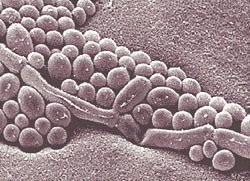Sticking the fungus way
 yeast growing on a medium can look beautiful. But some fungi can be dangerous. In the human body, they can coat medical implants with thin films causing serious complications in patients with hip and valve replacements. In fact, every year thousands of deaths can be traced to fungal infection formations on medical implants. Now, researchers at the Whitehead Institute for Biomedical Research, in the us, have found a key gene that allows fungi to stick to plastic surfaces and form thin coatings called biofilms. The gene, called flo 11, is essential for fungal biofilm formation. The results, published in Science lay the groundwork for finding ways to prevent biofilm formation.
yeast growing on a medium can look beautiful. But some fungi can be dangerous. In the human body, they can coat medical implants with thin films causing serious complications in patients with hip and valve replacements. In fact, every year thousands of deaths can be traced to fungal infection formations on medical implants. Now, researchers at the Whitehead Institute for Biomedical Research, in the us, have found a key gene that allows fungi to stick to plastic surfaces and form thin coatings called biofilms. The gene, called flo 11, is essential for fungal biofilm formation. The results, published in Science lay the groundwork for finding ways to prevent biofilm formation.
"Fungi represent a real threat because they can stick to plastic. A fungal infection can lead to complications for contact lens wearers and, more seriously, to patients with hip replacements. Often, the only way to treat the problem is to remove the implant,' says Gerald Fink, director of the Whitehead Institute. "Our work represents a key step toward understanding how fungi stick to plastic and offers hope that it may be possible to prevent such infections in the future,' he added.
In this study, the researchers found that baker's yeast (Saccharomyces cerevisiae) adhered to plastic plates, suggesting that like their infectious fungal cousins, yeast, too, can form biofilms. This came as welcome news to geneticists who have long used yeast as a model for infectious fungi such as Candida.
Knowing that bacteria use proteins on their surface to form biofilms, Todd Reynolds, one of the collaborators on the paper, set out to look for a yeast protein that allows them to stick to surfaces. When he made the yeast grow in a jello-like medium, the yeast began to spread out forming beautiful floral patterns. Reynolds pinpointed flo 11 as the gene required for this. He then found that the same gene also allowed yeast to stick to hard plastic surfaces. When the Fink lab disrupted the identified gene's functioning, yeast no longer formed the floral patterns and couldn't stick to hard plastic surfaces.
